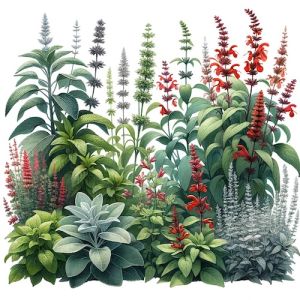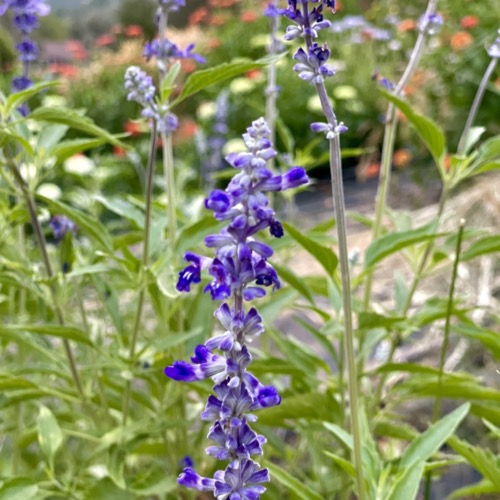The ‘Sage’ of the Garden
Salvia plants, a genus within the mint family, have captivated gardeners worldwide with their vibrant colors and rich history. From their native habitats to their role in traditional medicine, and their diverse cultivars, these plants offer a fascinating journey through the world of gardening. In this comprehensive guide, we’ll explore everything about Salvia, including where to find seeds, ideal growing zones and conditions, and tips on planting and pruning for an optimal floral display.
Native Habitat and Origin
Salvia, commonly known as sage, is native to a wide range of regions including Central and South America, Central Asia, the Mediterranean, and Eastern Asia. This extensive geographical spread has led to the evolution of a diverse range of species, each adapted to its unique environment. The natural habitats of Salvia range from desert margins to lush forests, showcasing the plant’s remarkable adaptability.
Salvia and Sage: Understanding the Connection
One common question among garden enthusiasts and culinary aficionados alike is whether salvia and sage are the same. The answer is intriguingly simple yet layered with botanical complexity. Salvia is the scientific genus within the mint family, Lamiaceae, and it encompasses a diverse range of species, including what we commonly know as sage.
The Botanical Link
- The Genus Salvia – This genus includes over 900 species, making it one of the largest in the plant kingdom. The diversity within this genus is remarkable, with species adapted to various climates and environments.
- Common Sage (Salvia officinalis) – When people refer to “sage” in a culinary or medicinal context, they are usually talking about Salvia officinalis. This species is renowned for its aromatic leaves, widely used in cooking and traditional medicine.
History of Natural Medicinal Use
Salvias have a long-standing history in traditional medicine, dating back to ancient civilizations. In various cultures, they have been used for their supposed healing properties, ranging from aiding digestion to serving as an anti-inflammatory agent. The most well-known, Salvia officinalis, also known as common sage, has been a staple in herbal medicine for centuries. It’s important to note that while historical use is significant, contemporary scientific research is essential to validate these medicinal claims.
Popular Salvia Cultivars
Which sage do you choose? Salvia cultivars can be broken down into two segments: Culinary and ornamental. Here is a quick overview below:
- Beyond Culinary Sage: While common sage is a well-known member of the Salvia genus, it’s just the tip of the iceberg. The genus includes annuals, perennials, and shrubs, showcasing a wide array of flower colors and forms.
- Ornamental Salvias: Many species of Salvia are cultivated for their beautiful and vibrant flowers. These ornamental varieties, such as Salvia splendens (scarlet sage) or Salvia nemorosa, are prized in gardens for their aesthetic appeal and attractiveness to pollinators like bees and hummingbirds.
The diversity of Salvia cultivars makes them a favorite among gardeners. Some popular varieties include:
- Salvia splendens (Scarlet Sage): Known for its bright red flowers, it’s a popular choice for adding a pop of color to gardens.
- Salvia apiana (White Sage): Revered for its aromatic leaves and cultural significance in Native American rituals.
- Salvia nemorosa (Woodland Sage): Praised for its long-lasting blooms and attractiveness to pollinators.
Where to Find Salvia Seeds
For those looking to grow Salvia, seeds are available at most garden centers, nurseries, and online seed catalogs. When purchasing seeds, look for reputable suppliers to ensure high germination rates and plant health. For rare or specific cultivars, specialized online retailers and botanical garden sales can be great sources.
Zones and Conditions
Salvia plants are generally hardy and can thrive in a wide range of conditions. They are suitable for USDA zones 4 through 10, though this can vary depending on the specific species or cultivar. These plants prefer well-draining soil and can tolerate a range of sunlight exposures, from full sun to partial shade. Regular watering and occasional fertilization will promote healthy growth, but they are also known for their drought tolerance, making them a good choice for xeriscaping.
How to Plant and Cut for Flowers
Planting Salvia is straightforward:
- Prepare the Soil: Choose a spot with well-draining soil and amend it with compost if necessary.
- Sowing Seeds or Transplanting: Plant seeds or seedlings according to the depth and spacing recommendations for your specific cultivar.
- Watering: Keep the soil consistently moist until plants are established.
To encourage vibrant and long-lasting blooms, pruning and deadheading are crucial. Cutting back the plant in early spring promotes bushier growth and more flowers. Regularly removing spent blooms will also encourage the plant to produce more flowers throughout the growing season.
Salvia plants are not just a beautiful addition to your garden; they are steeped in history and versatility. Whether you’re a seasoned gardener or a beginner, these plants offer an enriching experience with their vibrant colors, varied uses, and ease of care. Happy gardening!
More:
Sage, Salvia officinalis from UW
Frequently Asked Questions About Salvia Plants
- What is Salvia? Salvia, commonly known as sage, is a genus of plants in the mint family. It includes a variety of species, both culinary and ornamental, known for their attractive flowers and aromatic leaves.
- How many types of Salvia are there? There are over 900 species of Salvia, which include annuals, perennials, and shrubs. This diversity allows for a wide range of uses and adaptations to different environments.
- Can Salvia be used for cooking? Yes, certain Salvia species, like Salvia officinalis (common sage), are used in cooking. They add flavor to a variety of dishes, particularly in Mediterranean cuisine.
- Are Salvia plants easy to grow? Salvia plants are generally easy to grow. They are adaptable to various climates and soil types, though they prefer well-draining soil and a good amount of sunlight.
- How do I propagate Salvia? Salvia can be propagated by seed, cuttings, or division. The method depends on the species and the gardener’s preference. Seed propagation is common, but cuttings can provide a quicker start.
- Is Salvia attractive to pollinators? Yes, many Salvia species are known for attracting bees, butterflies, and hummingbirds, making them excellent plants for pollinator-friendly gardens.
- What are the medicinal properties of Salvia? Historically, Salvia has been used in herbal medicine for various purposes, such as aiding digestion and serving as an anti-inflammatory. However, the medicinal efficacy varies by species and should be researched or consulted with a professional.
- When is the best time to plant Salvia? The best time to plant Salvia is in the spring after the threat of frost has passed. This gives the plant time to establish itself during the growing season.
- How often should I water Salvia? Salvia plants generally need regular watering, but they are also drought-tolerant once established. The frequency of watering will depend on the climate and soil conditions.
- Can Salvia plants survive winter? Some Salvia species are perennial and can survive winter, especially in milder climates. However, in colder regions, they may need protection or to be treated as annuals. The survival of Salvia through winter depends on the species and local climate conditions.
- Are there any hallucinogenic effects associated with Salvia? Yes, one particular species, Salvia divinorum, is known for its psychoactive properties. It contains a compound called salvinorin A, which can induce hallucinations. It’s important to note that the use of Salvia divinorum for its psychoactive effects is regulated or banned in many countries due to its potent and unpredictable nature. This species is distinct from the culinary and ornamental varieties commonly grown in gardens.












You must be logged in to post a comment.